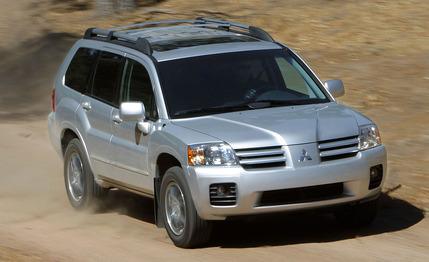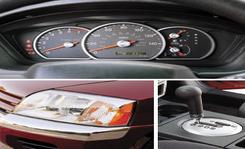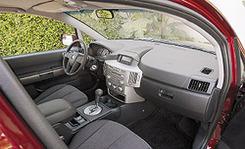
 First Drive Review
First Drive Review
Every crossover SUV needs a roomy interior with lots of cup holders, a truck-tough look, a car-soft chassis, and enough power to scale Target's intimidating speed bumps. Those in hand, each automaker then has to somehow make the resulting crossover stand out. From beak to flamboyant wing fenders to angular tail plumage, Mitsubishi's new 2004 Endeavor stands out.
Mitsubishi has sold SUVs in North America since 1983, but the Endeavor is the first assembled in, and engineered for, this market. It's built atop a new front-drive, unibody platform from which will also spring, most likely, the next Galant sedan and Eclipse coupe to be assembled alongside it at Mitsu's plant in Normal, Illinois. Stretching 190.2 inches over a 108.7-inch wheelbase, the Endeavor is about two inches longer than the Honda Pilot in both those dimensions and almost an inch longer than an Explorer (which has five inches more wheelbase). That puts the V-6-powered Endeavor in the main stream of the mainstream-SUV market.
But it looks positively Venusian. This product of Mitsubishi's California design studio is relentlessly interesting--sometimes in good exuberant ways and sometimes in not-so-good exuberant ways. The roof rack with crossbars (standard on midlevel XLS and upmarket Limited models) is a piece of thick-piped art, but the side mirrors look like afterthoughts. The small glass side panels where the A-pillars and the cowl meet just ahead of the front doors are neat, but do the Limited model's tiny round fog lamps need big square bumper holes? If its major competitors are bland toasters, the Endeavor is the aftermath of a meteoritic strike on a KitchenAid warehouse.


Under the off-planet cubist skin is a conventional mechanical package. The only engine is a transverse-mounted 3.8-liter SOHC 24-valve V-6 feeding a shiftable Sportronic four-speed automatic and, in all-wheel-drive models, a center differential distributing torque 50/50 front to rear. The front suspension is a strut type; the rear is a multilink. It's all typical crossover-SUV stuff.
Based on the 3.5-liter V-6 offered in the Montero Sport (itself based on that SUV's standard 3.0-liter V-6), the 3.8's extra displacement results from a bump in bore from 93 millimeters to 95 and a jump in stroke from 85.8mm to 90. Unfortunately, the iron-block, aluminum-head V-6's big cubes don't translate into large power numbers. Its rating of 215 horsepower at 5000 rpm tops the Montero Sport 3.5's 197 horsepower but lags behind both the Pilot's 3.5-liter VTEC V-6's 240 horses and the Toyota Highlander's 220-hp, 3.0-liter V-6. In compensation, the Mitsu's motor makes eight more pound-feet of peak torque than the Honda's and does so 750 rpm earlier (3750 rpm). Sure, the Honda has a fifth gear in its transmission, but it also weighs about 300 pounds more than the Endeavor.


The visual onslaught continues inside. The easily read main instruments sit under a binnacle and glow blue at night but are otherwise ordinary. The center of the dash is styled like a Bangles-era Aiwa boombox with a metal-like finish and large dials and buttons to control the sound and ventilation systems, capped by a pictographic LCD display that provides a slew of information, including outside temperature, a compass, and news of ventilation status. Base LS models have a CD player; the two higher lines have an in-dash, six-disc changer. For some, the Circuit City looks are too much. For us with fond memories of Susanna Hoffs in spandex, it's rad!
Mitsubishi has done a fine job with interior textures such as the pebbled and dimpled surface of the steering wheel and the soft feel of the vast dash pad. The seats are flat but comfortable, legroom is good, especially in back, and there are enough 12-volt outlets to power a cell phone, a computer, an Xbox, and a margarita blender. But conspicuously absent are a navigation system and a third row of seats. Who cares about a nav system? But having no third row may be a strategic mistake as the five-passenger Endeavor confronts the nominally eight-seat Pilot.